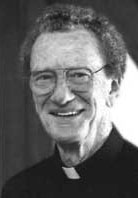THE ALCATRAZ INTERVIEWS
A Jesuit Who Reached Out to Hardened Criminals
Father Bernard Bush, S.J., assisted Father James Tupy, S.J., on Alcatraz from 1958–1962 when Father Bernard was a Jesuit theology student. While not yet a priest, the convicts called him “Father.”
1.
Were you ever afraid while on Alcatraz?
 No. The convicts liked me. I brought them news from the outside and I wasn’t a guard. I felt protected. The guards were nervous about me being there. While I was in the prison yard, I would look up and they would have their guns trained generally in the direction where I was with the men gathered around me.
No. The convicts liked me. I brought them news from the outside and I wasn’t a guard. I felt protected. The guards were nervous about me being there. While I was in the prison yard, I would look up and they would have their guns trained generally in the direction where I was with the men gathered around me.
2.
What were the convicts like?
They were hard people. Tough. When I got to know them they were friendly but I had no illusions about what their lives had been like before Alcatraz. One prisoner I became friendly with was Paul “Frankie” Carbo who I later found out was a member of Murder, Inc. [Murder, Inc. was a name given to a group of contract murderers in the 1930’s and 1940’s. Murder, Inc., was the muscle behind the Mafia.]
3.
You were a swimmer and the swimming coach at St. Ignatius College Preparatory School. You said this made you popular with the inmates. Is that just a joke?
Oh, no. They were dead serious about their interest in swimming. They asked all kinds of questions about the water temperature, the currents, the tides, the sharks. The guards told them there were man-eating sharks in the water but I let them know that wasn’t true. Not in the Bay. It was too shallow.
4.
Did the convicts have any pets on Alcatraz?
One convict had a mouse named Stumpy who had no front legs. He was trained when the convict would rap on the table twice, he would run up his sleeve and into his pocket.
5.
While on Alcatraz you became close friends with a prisoner named Larry Trumblay. Can you tell us a bit about that?
One day I was in the recreation yard where the men were playing cards, playing handball, lifting weights, and walking around. One man had his eyes closed, sunning himself. He was a tough looking guy. I introduced myself to him and struck up a conversation. I asked him what he did, which you’re not supposed to do since it is against prison etiquette. He said: “They told me I held up some banks.” Later, when I mentioned to Warden Madigan that I had talked to Trumblay, Madigan said: “You’re wasting your time with him.” The warden showed me his “rap sheet.” He had not earned any good time in the years he had been there because he was involved in one scrape or another.
6.
Did you continue to visit with Trumblay?
Yes, I always made a point of visiting with him even when he was in “The Hole.”(The disciplinary cells on Alcatraz called the “TU”, Treatment Unit.) One day he said he’d like to repay my visit. I said to him: “If you come to San Francisco dripping wet, forget it.”
7.
But you stayed friends?
Yes, I have about fifty or sixty letters from Trumblay. Even after Alcatraz closed, we stayed friends. From Alcatraz, Larry was sent to the federal prison at Leavenworth, Kansas, and eventually he was paroled. We got permission from the Attorney General of the United States for him to come to California. So on June 4, 1965, Larry was at my ordination. He gave me something that day to remember him and the boys by. It was an alb [a special religious garment worn by priests], which he had designed and crocheted in his cell at Alcatraz. I wore it for my ordination and first Mass.
8.
Now you are a retreat director at the Jesuit Retreat Center of Los Altos. What is the main difference in the kind of spiritual assistance you give now versus what you did while on Alcatraz?
On Alcatraz I wasn’t trying to guide or convert, only to be a friend. Now, in my work my conversation is more focused on God.
Father Bernard Bush, S.J., is a retreat director at the Jesuit Retreat Center of Los Altos.
Interviewed by Gennifer Choldenko in Los Altos, CA, on June 28, 2013.

